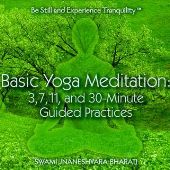|
|
Sankhya Yoga,
Prakriti and its Evolutes:
Returning to Self-realization
by
Swami Jnaneshvara Bharati
SwamiJ.com

Rediscovery of pure consciousness: The
process of Self-realization is one of attention reversing the process of
manifestation,
of retracing consciousness back through the levels of manifestation to its source.
To have a general understanding of this process is extremely useful, if
not essential in the practice of Yoga.
Evolutes
of
Unmanifest Matter
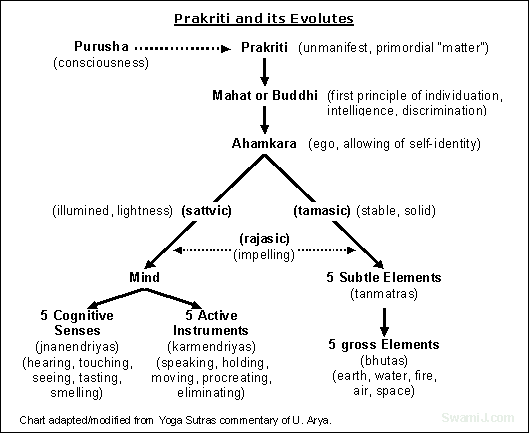
(See also the chart below on
retracing)
You don't have to know
much: As you read through the descriptions below, please keep in mind that it
really does not take a tremendous amount of understanding of these
subjects to begin doing the
self-awareness and meditation practices.
If you understand the
general principle of systematically shifting awareness inward through
the evolutes, then the process of meditation can truly be directed
towards Self-realization, and not merely relaxation designed for stress
management (as useful as that might be). The subtler and subtler
practices and insights will come with practice, built on the foundation
of simple understanding. With practice, the
principles of Purusha and the evolutes of Prakriti become ever more
clear.
Real and Unreal:
Sankhya philosophy views anything that is subject to change, death,
decay or decomposition as being "unreal" rather than "real." This does
not mean that the objects are not there in front of you. Rather, they
are not ultimately "real" in that their form keeps morphing from this to
that to the other. What is considered "real" is that final substratum
which never changes, cannot die, and cannot possibly decay or decompose.
It is the direct experience of that "absolute reality" which is being
sought.
Something evolves out of something:
Ornaments can be said to evolve out of metal. Pots can be said to evolve
out of clay. Our world is filled with objects. Objects are made of
compounds. Compounds are made of molecules. Molecules are made of atoms.
Atoms are made of particles. Particles are made of a subtler substratum.
While one evolves out of the other, all of these levels of reality coexist
and interact with one another.
Humans are also multi-leveled: So too, is the construction of the human being. We are
multi-leveled beings, with the next level emerging out of the previous,
while those levels still coexist and interact with one another (see the charts). While the human is made of physical material, we are also
constructed of subtler levels of reality, which are products of the
unmanifest, primordial essence called Prakriti in Sanskrit.
Familiar human evolutes: We are all
familiar with the process by which our quiet mind has a memory arise,
which triggers emotions, causing chains of thoughts to emerge from that,
and to then further emerge into actions and speech. Each of these is a
process of one level of functioning emerging or evolving out of the
previous, while each of those levels still exists on its own. (See also
the article on Karma and the Source of Actions,
Speech, and Thoughts)
In this
way, the actions and speech (which emerged from mind) still coexist with
the whole of the conscious mind, as well as with the whole domain of the
unconscious mind, and also with the still, silent center of pure
consciousness (whatever we might call this consciousness, or however we
might individually perceive it). All of these coexist, while one
leads to the next, with the grosser emerging from the subtler. So it is
with all the levels of Prakriti.
Evolutes of Prakriti:
Similarly, our whole being, in the spiritual sense, is multi-leveled,
with the next stage emerging or evolving from the previous. This is
the subject of Prakriti, which can be loosely described as unmanifest,
primordial matter (which is subtler than the gross realm of quantum
physics). This Prakriti ("matter") is infused with pure
consciousness, which is called Purusha. Here, however, we are not just
talking about the evolutes of chains of thought and emotions, but also
the evolutes of the instruments by which we think and emote. This is
taking us to the core of our being.
Experiencing consciousness alone:
Yoga has been described as a process of
realizing the direct experience of consciousness (Purusha) as independent of all
levels of false identity (manifestations of Prakriti). These false identities are all seen as evolutes
of the primordial stuff or matter (Prakriti) from which they
emerge. Purusha (consciousness) is actually at all times independent of
the interplay, but has become falsely identified with all of this.
Retracing our way back: The reason this is important is that
the process of enlightenment (or awakening) is one of reversing the
process, of tracing our way back through the stages of evolutes.
The chart above shows the evolutes, and the chart below shows the
journey of tracing our way back to consciousness alone, which is the
meditation process of systematically withdrawing consciousness from the
evolutes.
Sankhya-Yoga: What we now call
"Yoga" or "Raja Yoga" has also been called "Sankhya-Yoga,"
since the practical Yoga methods rest on the philosophical foundation of
Sankhya, which is represented in the chart above. This is a widely held
view of the relationship between Sankhya and Yoga (See also the article
entitled
Six
Schools of Indian Philosophy). Some may not agree with this
perspective, but that is a matter for the scholars to debate. Sankhya
is thus the foundation for the Yoga described by Patanjali in the Yoga
Sutras.
To debate or not debate: Some
intellectuals will also debate furiously and endlessly about whether the ultimate
nature of reality is dualistic or non-dualistic. Some will say that Purusha
(as consciousness) and Prakriti (as matter) are eternally
separate, and therefore, ultimate reality is dualistic. Others will
argue that the two are ultimately seen to be one and the same, and
ultimate reality is non-dualistic. However, the seeker of direct
experience through the practices of Yoga need not enter these debates
intensely. While there may be some value in reflecting on these
principles, and maybe even forming a provisional opinion, what is far
more important is to understand and actually do the practices.
(See also the article, Dualism and Non-Dualism)
This is very practical: Here, in
this article, the evolutes of Prakriti are being presented as practical
information for the modern seeker who is not a scholar or philosopher,
but is a seeker trying to gain a basic understanding that will
facilitate personal meditation practices. By having a working knowledge
of the evolutes of Prakriti, the journey of moving attention in the
reverse direction (involution) makes much more sense.
Universal principles: It is most
important to note that the principles here are also contained in many
other systems, although they may not be explained or used in precisely
the same way. For example, the concepts of mind and senses, gross and
subtle elements, and ego and intelligence, are universal principles.
These are also included, for example, in Vedanta and Tantra as well, and
also many other traditions. This is not said to force all of the many
traditions into one box, but to help allow us to seek and see the
underlying reality that is trying to be explained and reached through
the practical application of the practices.
Uncovering false identities: The
practices have to do with systematically uncovering the many false
identities we have taken on by Purusha (consciousness) commingling with Prakriti
(matter) (See Yoga
Sutra 1.2). By starting with the gross levels (Yoga
Sutras 2.1-2.9) of these false identities, and gradually discerning
deeper and deeper (Yoga
Sutras 2.10-2.11), our true nature will ultimately be revealed
through direct experience (Yoga
Sutras 1.3 and particularly Yoga
Sutra 3.56).
Descriptions of the Evolutes of Prakriti: Following
are some brief descriptions of the evolutes of Prakriti, which are in
the two tables shown in this article. The most important principles are that of
Purusha and Prakriti, which are consciousness and primordial matter. Everything else
emerges from Prakriti, and then is infused with Purusha. So, for
example, all the levels of manifestation of the human (gross and subtle)
are Prakriti, but have life due to the infusion of Purusha. One of the
easiest ways to grasp this process of evolving and infusing, as well as
arising from and receding into Prakriti, is to scroll down and read
about the way the senses operate. The other evolutes arise and recede in
a similar way.
Purusha: Of the two companion
principles, Purusha is consciousness that is untainted, ever-pure. It is
self-existent, standing alone from other identities of individuality;
conscious being-ness; the principle of spiritual energy.
Prakriti: The other of the two
companion principles, Prakriti is the unconscious, unmanifest, subtlest
of the material aspect of energy. It is the primordial state of matter,
even prior to matter as we know it in the physical sense. Prakriti manifests as the three gunas and the other evolutes.
Mahat or Buddhi: This is the
purest, finest spark of individuation of Prakriti (primordial matter).
It is very first of the evolutes of Prakriti. It is individuation, but
yet, without characteristics. Buddhi is the word, which applies to the
individual person, while mahat refers to the universal aspect of this
process. (See Four Functions of Mind)
Ahamkara: This is the process of
ego, by which consciousness can start to (incorrectly) take on false
identities. Here, the word ego is used not to mean the actual
qualities such brother or sister, or loving or cruel, but the capacity
itself to take on the countless identities. (See Two
Egos section of Four Functions of Mind)
Gunas: Prakriti (primordial
"matter") has three characteristics or attributes of lightness
(sattvas), activity (rajas), and stability (tamas). These three combine
and re-combine so as to form the various aspects of mind, senses, and
the five elements: earth, water, fire, air, and space.
Mind: Mind (manas) is the
instrument, which is the driving force behind actions, speech, and the
thinking process. It is also the recipient of the sensory input. It is
useful to know that, here, mind is being used in this more
limited way, rather than the whole of the inner process called antahkarana,
which includes manas, ahamkara, buddhi, chitta, along with the senses
and the five elements.
Senses/Instruments: The five
senses and five instruments of expression are like ten doors of a
building. Five are entrance doors, and five are exit doors. These
ten indriyas are evolutes of mind.
One way
to understand this process of the senses being evolutes of mind is to
notice what happens when you fall asleep, into dreamless sleep. What
happens to your senses, your ability to perceive through those senses?
They seem to go away, yet they return after sleep. Where did they go? It
is in that sense that we might say the senses are still there, but that
they have receded back into the field of mind from which they arose
in the first place.
This same process of arising and receding happens
not only with the senses, but all of the evolutes of Prakriti.
Also, if
the senses arise from and recede into the field of mind, then it is also
easy to see that during times when the senses are operating, they are
also infused
with mind, the next subtler level of Prakriti. In other words, senses
without mind operating through them simply do not work. The idea of
senses operating without mind infusing them seems rather silly, in fact.
It is that simplicity that is in the whole concept of Prakriti manifesting outward, and the process of meditation retracing that
process inward.
Elements: A further outpouring
of Prakriti is when it bursts forth as the equivalent of space, as
experienced in the subtle (non-physical) realm. From, and within that
emerges air (thinness, lightness, airiness), then fire (energy), then
water (flow, fluidity), then earth (solidity, form). When these five
elements are in the subtle realm, they are known as tanmatras. When they
further come outward, manifesting into the physical world, they are
known as bhutas. From these, all of the many objects of the external
world are composed.
Senses experiencing the Elements:
Notice that the Senses and Instruments of action (Indriyas) emerge out
of unmanifest matter, or Prakriti. Notice that the five Elements also
emerge out of Prakriti. Thus, one set of evolutes (Senses and
Instruments of action) are relating to another set of evolutes (the five
Elements in the form of many objects). This is one way of explaining the
mechanics of how it can be that all is one can appear to be multiplicity.
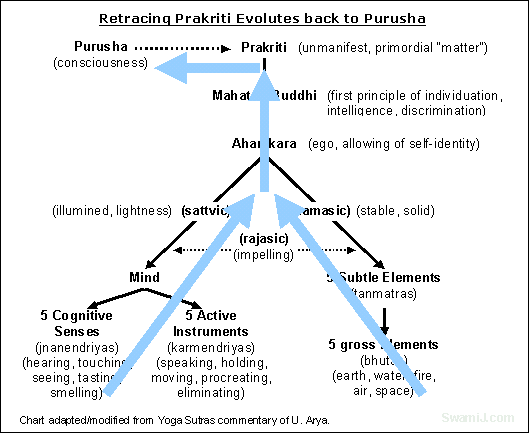
If this looks difficult: If this
information is new to you, and looks difficult or confusing, please keep
in mind that there are only a small number of principles on the charts
above (about 25-30, depending on how you count them). While they might
seem overwhelming, this really is a manageable number of principles to
gradually learn.
By comparison, think of how you have learned to use the
browser software with which you look at this web page. When I count the
number of pull-down options on the menu of Internet Explorer, there are
about 75 different commands that I have gradually come to use, and I'm
no computer expert. To type a paper in Word, there are over 100 commands
in the pull-down menus that I now know how to use.
This is not to say
that self-awareness training is as easy as learning to use a computer.
However, please don't feel too overwhelmed by the handful of principles
of self-awareness. Gradually, understanding comes, and it comes through
repetition and practice, just like learning to use your computer.
One of
the beautiful parts of this process is that there really are only a
handful of these principles through which consciousness gradually moves
so as to then experience its true nature. Cultivating such a perspective
makes the process simple to see, though not necessarily easy to do.
However, understanding the simplicity sure is a nice place to start!
Summarizing the process of retracing: It is not
possible to thoroughly describe the retracing process of the
evolutes of Prakriti in this paper, as that would mean, at a minimum,
recapping the entire Yoga Sutra here in this small section. However, in
the spirit of keeping it simple, it is very useful to summarize in
straightforward terms, so as to have a basic grasp
of the evolutes and their involution so that the practices can be done.
Shortcuts: It is important to
note and remember that, while the retracing method of Sankhya-Yoga leads
one systematically inward to direct experience, there is also the shortcut
from bestowing of direct experience, grace, or shaktipat,
whether you hold that as coming from God, Guru, or some other
explanation of such gift. The sage Vyasa, the most noted commentator on
the Yoga Sutras, mentions this in his comments on Sutra
3.6.
Means of Retracing Prakriti to Purusha: The journey of Self-realization, or discrimination of pure
consciousness (Purusha) from unmanifest matter (Prakriti) is one of
systematically using attention to encounter, examine, and transcend each
of the various levels of manifestation, ever moving attention further
inward towards the core of our being (See Yoga Sutras 2.26-2.29
and 3.53-3.56).
The descriptions below are
intended to give you a feel for this inner process, not to be
literal, step by step instructions. While the systematic process below
is accurate, the specific practices are the subject of the Yoga
Sutras. Hopefully, by better understanding the general process
below, the meditation processes and practices of the Yoga Sutras will be
clearer.
Meditation on objects composed of the five
elements: Meditation often starts with awareness of gross objects
of one kind or another. It might be be done with the eyes open, or
with the eyes closed. It might be some religious or spiritual object,
a picture, a geometric form, or a point of concentration, such as a
candle flame or light visualized in the inner mind field. The object
of attention might be scanning ones own physical body, or awareness of
the mechanics of breath regulation.
In each of these and other cases,
we are dealing with the gross world of objects, which are each related
to the world of earth, water, fire, air, and space. One might use a
single object of meditation, or a variety of objects. The objects
might be constructed of the physical five elements (bhutas) or their
subtle counterparts (tanmatras). They might be experienced as solid or
heavy, like in the waking state, or as thin or vaporous, like in the
dreaming state.
One might focus on many such constructed gross
and subtle objects for many years. However, we might move to subtler
meditation, where the object of meditation becomes the five elements themselves,
and the sensing instruments themselves.
Meditation on the five elements
themselves:
Gradually, as the meditator progresses in attention training, there
comes the ability to focus on and explore each of the five elements themselves,
one at a time. This can sound a bit baffling at first, because the
element itself does not have form, in the conventional
sense of a form having shape and dimensions, etc. Here, you are seeing
more subtly how all objects are constructed, which helps to
temporarily set aside all such objects during meditation.
You are
literally meditating on the element of earth, or water, or
fire, or air, or space. Because you see all of the grosser objects as
being only constructs (made of the five elements),
non-attachment comes more easily and naturally (See Yoga Sutras 1.12-1.16
on vairagya, Sutras 2.10-2.11 on
subtle meditation, and Sutras 3.45-3.46
on the five elements).
Meditation on senses or means of cognition
(jnanendriyas): As meditation progresses still further, we come to
explore the senses themselves, as objects of meditation. We are
now examining the instruments with which we experience all of
those objects (described above). The senses (jnanendriyas)
are our doorways to the external world. Imagine for a moment the way a
telescope works.
- There is some object out there, such as a
mountain in the distance.
- There is a person in here
("me" or "I"), who is experiencing that distant
mountain.
- The telescope is a third part of this process, and is the instrument
by which the perception occurs.
In this metaphor, we might focus our
attention not only on the mountains in the distance (the objects), but
we might also focus attention on the telescope itself, the instrument
with which we have previously been using to look at the mountains.
Similarly our five cognitive senses
(smelling, tasting, seeing, touching, and hearing) are instruments
by which the indweller (however you conceptualize or name that)
experiences the external world. As meditation progresses, we turn our
attention inward, in such a way that we are examining those instruments
themselves.
Those senses appear to be
physical instruments, such as a physical eyeball. However, we also,
for example, see in our dreams, so we come to understand that
the sense of sight (as well as the other senses) are internal or
mental processes.
In our meditation practices, whether at seated
meditation time or meditation in the world (mindfulness, if you
prefer), we first may use our senses to explore and witness objects
(whether physical or mental). However, at some point we withdraw our
senses from those objects, and begin to explore the nature of the
senses themselves, or the other internal evolutes of Prakriti, which
do not seem to be objects in the conventional sense of physical
objects.
Meditation on instruments of action
(karmendriyas): The instruments of action (karmendriyas)
are also doorways to the external world. These instruments
(elimination, procreation, motion, grasping, and speaking) are the
means by which the indweller expresses outward into the world.
So, these instruments of action
(karmendriyas) are the exporters, so to speak,
while the cognitive senses (jnanendriyas) are the importers. Both are in service of
the indweller. Together, they form a complete communication system
between the inner and the outer.
At meditation time, we not only turn
the cognitive senses inward, we also withdraw these instruments of
action as well. This is why, at the grossest level of meditation
practice, we both close our eyes and we sit still; one has to do with
the exporter, and the other with the importer. This is a process of turning
inward of the jnanendriyas and the karmendriyas.
As with the senses
(noted above), the instruments of actions themselves also become
objects, so to speak, of exploration in meditation. We learn to
witness the tendencies of expression themselves. We become aware of
the inclinations toward moving and speaking, for example,
becoming literally aware of the cessation of these processes, as we
come inward towards stillness. It is as
if the senses and instruments of action are beginning to come inward
in such a way that they are receding back into the mind and Prakriti from which they originally emerged. This process of withdrawal of the
ten indriyas is described in the Yoga Sutras, as part of
Pratyahara, which is rung 5 of the 8 rungs of Yoga (Yoga Sutras
2.54-2.55).
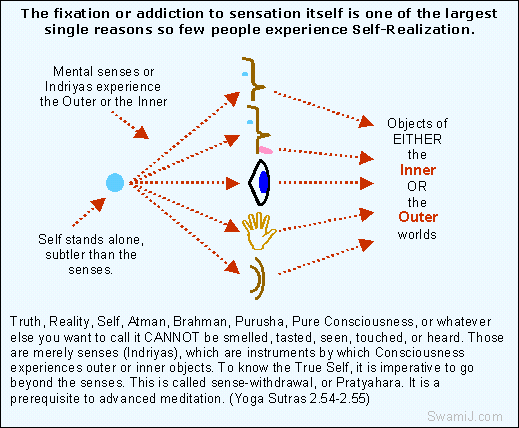
Meditation on mind itself: Notice
in the charts above that the senses and means of cognition (Indriyas)
as well as the five elements (Tanmatras and Bhutas) emerge from the
field of mind (Manas) at the very subtle level of mind. Gradually, one
has the ability to use mind itself as the object of meditation.
This is extremely subtle, beyond our normal idea of what it means to
witness the flow of thoughts in the mind. Here, again, we are
literally aware of the instrument of mind itself.
In the eight
rungs of Yoga (Yoga Sutra 2.29),
rung five is Pratyahara, the withdrawal of the senses. This is often
mistaken to mean that we sit still and close our eyes. While that is
very important, it is not the real meaning of sense withdrawal, or
Pratyahara. Here, when we truly turn attention inward from not only
the typical objects of attention, but also inward from the
senses themselves, we encounter the deeper ability to concentrate on
mind itself. Mind itself is formless, in the conventional sense of an
object having shape and dimensions, just as the senses and elements
were also described as formless in the conventional sense.
Like
meditation on the elements and the senses themselves (as objects), awareness of
mind (Manas) itself has a bewildering quality to it, as we come back
into our day-to-day awareness and try to understand or explain this.
By being aware of this, it is easier to hold the subtlety of such
experience.
Meditation on I-am-ness: Most
of the time we mistakenly think that "who I am" is my
mind and personality. However, as we gradually come to witness the
subtle elements, the senses, and the mind itself, we come to see that
there is a still subtler aspect, which simply declares "I
am!" When it stands alone in this way, it is independent of the
other manifestations.
To be aware of this
"I-am-ness" (Ahamkara) is a further stage along the journey
to realization of pure Consciousness (Purusha). This Ahamkara
(literally "I-maker") becomes the coloring agent for
attachments and aversions, which define our personalities and false
identities. In meditation on this subtle level, those have subsided
along with the senses.
Notice, once again, that the process
is similar to dealing with gross objects of meditation, as well as the
elements and senses. Something emerged from something, and now we are
simply becoming aware of that substratum, letting go of the more
surface manifestations. (Take a look at the third level of
concentration in Yoga Sutra 1.17,
which is on I-ness. Also see the article on the Four
Functions of Mind).
Meditation with Buddhi standing alone: Still
subtler is Buddhi, which is the individuated intelligence itself. It
doesn't yet declare itself to be this or that identity, but is the
very intelligence, which supports the ego (Ahamkara), the senses and
instruments of actions (Indriyas), and the constructs of the inner
objects and physical body (Tanmatras and Bhutas).
One of the final resting places of
the individuated person is to know oneself as Buddhi, this most
fine vehicle of consciousness (Purusha). It is still constructed of
Prakriti, leaving that final discrimination or uncovering yet to be
done. To know oneself at this level of Buddhi is sometimes called the
level of bliss or ananda, as all of the other levels and false
identities have temporarily come to rest or been transcended.
Purusha
resting in itself: Finally Purusha, pure consciousness, rests in
itself, alone, separate from all evolutes of Prakriti. The seeker on the path of Self-realization seeks even a minute
or a moment of this highest glimpse of Realization, after which he or
she continues to purify the remaining samskaras and karmas. (See
Yoga Sutras 1.3 and
3.56)
Keep it simple: As already said
above, these descriptions are
intended to give you a feel for this inner process, not to be
literal, step by step instructions. The specific practices are the subject of the Yoga
Sutras. The journey is systematic, and flows much more smoothly by
having a general understanding of the process. This understanding, along
with oral counsel, and the most important part of all, which is
practice, gradually brings one to direct experience, which is the
goal.
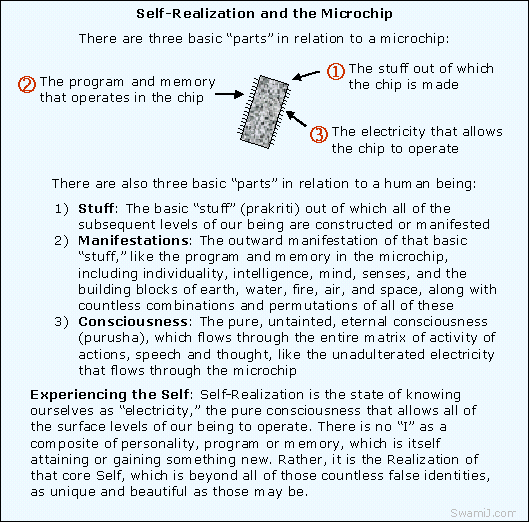

-------
This site is devoted
to presenting the ancient Self-Realization path of the Tradition of
the Himalayan masters in simple, understandable and beneficial ways,
while not compromising quality or depth. The goal of our sadhana or
practices is the highest Joy that comes from the Realization in
direct experience of the center of consciousness, the Self, the
Atman or Purusha, which is one and the same with the Absolute
Reality. This Self-Realization comes through Yoga meditation of the
Yoga Sutras, the contemplative insight of Advaita Vedanta, and the
intense devotion of Samaya Sri Vidya Tantra, the three of which
complement one another like fingers on a hand. We employ the
classical approaches of Raja, Jnana, Karma, and Bhakti Yoga, as well
as Hatha, Kriya, Kundalini, Laya, Mantra, Nada, Siddha, and Tantra
Yoga. Meditation, contemplation, mantra and prayer finally converge
into a unified force directed towards the final stage, piercing the
pearl of wisdom called bindu, leading to the Absolute.
|
|





